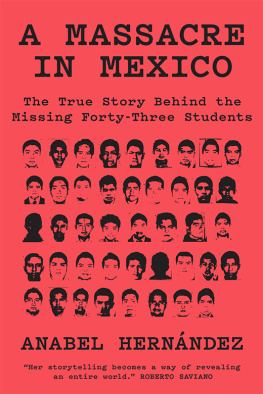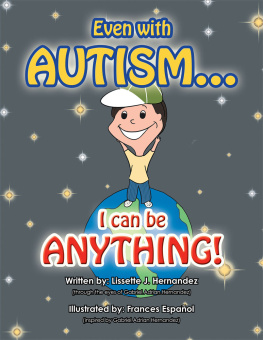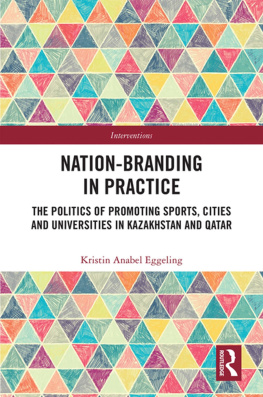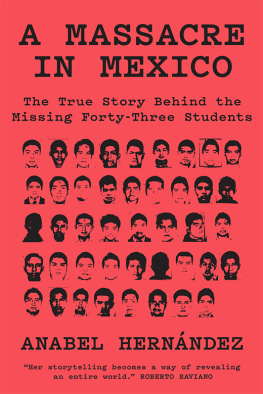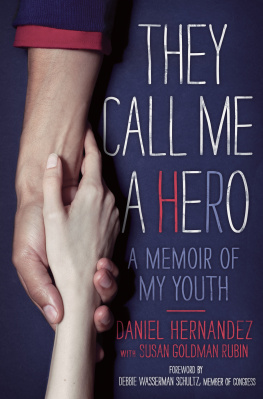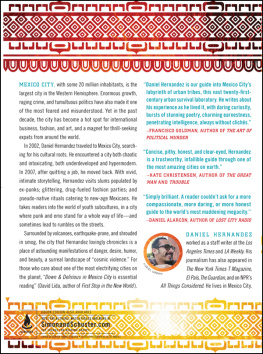Anabel Hernández - A Massacre in Mexico: The True Story Behind the Missing 43 Students
Here you can read online Anabel Hernández - A Massacre in Mexico: The True Story Behind the Missing 43 Students full text of the book (entire story) in english for free. Download pdf and epub, get meaning, cover and reviews about this ebook. year: 2018, publisher: Verso Books, genre: Detective and thriller. Description of the work, (preface) as well as reviews are available. Best literature library LitArk.com created for fans of good reading and offers a wide selection of genres:
Romance novel
Science fiction
Adventure
Detective
Science
History
Home and family
Prose
Art
Politics
Computer
Non-fiction
Religion
Business
Children
Humor
Choose a favorite category and find really read worthwhile books. Enjoy immersion in the world of imagination, feel the emotions of the characters or learn something new for yourself, make an fascinating discovery.
- Book:A Massacre in Mexico: The True Story Behind the Missing 43 Students
- Author:
- Publisher:Verso Books
- Genre:
- Year:2018
- Rating:4 / 5
- Favourites:Add to favourites
- Your mark:
- 80
- 1
- 2
- 3
- 4
- 5
A Massacre in Mexico: The True Story Behind the Missing 43 Students: summary, description and annotation
We offer to read an annotation, description, summary or preface (depends on what the author of the book "A Massacre in Mexico: The True Story Behind the Missing 43 Students" wrote himself). If you haven't found the necessary information about the book — write in the comments, we will try to find it.
A Massacre in Mexico: The True Story Behind the Missing 43 Students — read online for free the complete book (whole text) full work
Below is the text of the book, divided by pages. System saving the place of the last page read, allows you to conveniently read the book "A Massacre in Mexico: The True Story Behind the Missing 43 Students" online for free, without having to search again every time where you left off. Put a bookmark, and you can go to the page where you finished reading at any time.
Font size:
Interval:
Bookmark:

the Missing Forty-Three Students
Anabel Hernndez
Translated with an Introduction by John Washington

First published in English by Verso 2018
First published as La verdadera noche de Iguala. La
historia que el gobierno quiso ocultar 2017
Vintage Espanol 2017
Translation John Washington 2018
Introduction John Washington 2018
All rights reserved
The moral rights of the authors have been asserted
1 3 5 7 9 10 8 6 4 2
Verso
UK: 6 Meard Street, London W1F 0EG
US: 20 Jay Street, Suite 1010, Brooklyn, NY 11201
versobooks.com
Verso is the imprint of New Left Books
ISBN-13: 978-1-78873-148-5
ISBN-13: 978-1-78873-536-0 (EXPORT)
ISBN-13: 978-1-78873-151-5 (US EBK)
ISBN-13: 978-1-78873-150-8 (UK EBK)
British Library Cataloguing in Publication Data
A catalogue record for this book is available from the British Library
Library of Congress Cataloging-in-Publication Data
A catalog record for this book is available from the
Library of Congress. The LCNN is 2018016253
Typeset in Fournier MT by Hewer Text UK Ltd, Edinburgh
Printed in the US by Maple Press
To all the victims of that interminable night: those who were disappeared, the survivors, the tortured, and the witnesses who had the courage to speak out.
To Roberto Scarpinato, whose capacity to fall in love with the destiny of others is a source of inspiration and hope.
They sought to bury them, not knowing that they were seeds
Anon.
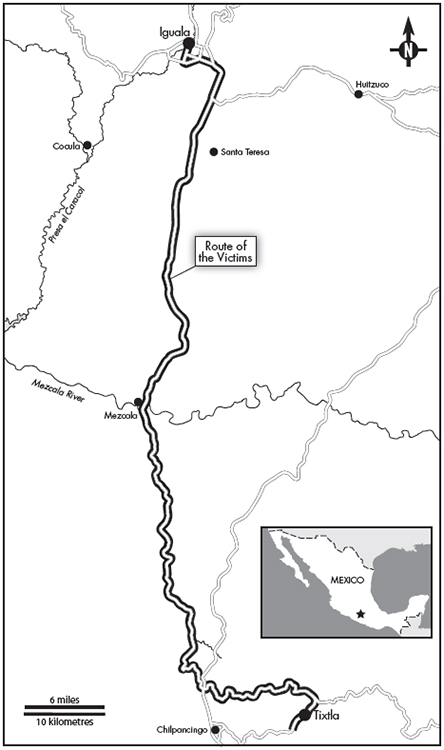
W ith no clear end, and no obvious beginning, this is a story that bleeds beyond linear timelines or basic geography. In the fall of 2014, a group of students from the Ayotzinapa teacher training school, mostly in their early twenties, commandeered passenger buses in the small city of Iguala, Guerrero. They took the busesan established, if, to some locals, annoying practiceto travel to Mexico City to commemorate the 1968 Tlatelolco Massacre, in which Mexican soldiers and police gunned down hundreds of innocent protesters. On that fall night in 2014, following a standoff earlier in the day, local, state, and federal security forces hunted down the unarmed students, shot and killed six people, injured dozens, and disappeared forty-three, all under the watchful and directive eye of the Army. After the disappearanceas news of the slaughter began to break across the worldthe government tampered with evidence, fabricated stories, lied to the international press, and brutally tortured the innocent men and women on whom it tried to pin the attacks. Tens of thousands of Mexicans took to the streets, chanting Fue el estado!
They were right, it was the state, and the demonstrations pushed the administration to the brink of collapse. Four years later, after weathering the storm with obfuscation, hollow promises, and a distracting onslaught of other scandals, the government remains in contempt of truth and in contempt of life. This is the endlessness of the story, the unhealing wound: no clarity, no justice. And every time or place you think youve found the beginning of the threadtracing the story back days, weeks, or decadesyou come across another tangle. Anabel Hernndez doesnt unsnarl all these shambles; rather, she presents the facts and history such that we glimpse an institution of cruelty and injustice that reaches far beyond that single night.
The massacre and disappearance of the students was different from other state-enacted slaughters of civilians only in degree, not in kind. Just months before the students were hunted down, twenty-two people were summarily executed by soldiers in Tlatlaya, in the state of Mexico. Their deaths stood out from the over 200,000 people killed in the decade of the drug war, as, despite government claims they had died in a standoff, the Army lined the victims up against a wall and shot them point-blank. They then tortured the sole surviving witness. Later, information was leaked that the soldiers hadnt merely been acting in wrath, they had been following orders.
Follow the thread, prod at another tangleblood feeds into Guerreros fertile soil. 2011: two Ayotzinapa students killed by police during a protest. 1995: the Aguas Blancas massacre, at least seventeen farmers slaughtered as they protested, among other things, for their right to clean water and against the disappearance of one of their leaders. These sorts of cold-blooded killings became common practice during the Dirty War, during which, from the late sixties to the eighties, the government killed and disappeared thousands, most notoriously in the 1968 Tlatelolco Massacrethe crime that the students were planning to commemorate in Mexico City. The violence seems to feed off itself, but thats not how violence works. Theres always someonein this case, el estadoholding, aiming, and firing the gun.
The students killed and disappeared that night were normalistas, studying at the Ral Isidro Burgos Normal Rural School in the small community of Ayotzinapa, in Guerrero state. The system of Normal Rural schools, based on pedagogy developed in seventeenth-century France, was initiated after the Mexican Revolution to train teachers in remote and mostly indigenous areas that the government had long neglectedand continues to neglect. Situated in areas of extreme poverty, with little to no infrastructure and high infant mortality rates, the Normal schoolsoffering free tuition and boardstand out as enclaves of opportunity and empowerment. The Normal schools afford alternatives to the local youth, those who want to remain in their communities.
The other options, which are few, include succumbing to the centripetal maw of Mexico City, signing up as pawns in the drug trade, or crossing the Arizona desert into el otro lado, where they would become prey for another violent paramilitary organizationthe US Border Patrol. For decades, Mexicos normal schools, though underfunded, politically undermined, and occasionally shuttered by the state, have been struggling to continue offering self-empowerment, indigenous pride, and the basic staples of education and community ethics to populations often relegated to cultural and economic attrition. It wasnt only those students who were attacked that nighttheir way of thinking, being, and even speaking have been tyrannized by the state for decades.
In the late sixties, Lucio Cabaas, the most famous alumnus of the Ayotzinapa Normal School, after witnessing and suffering multiple assaults from the police and the military, joined a nascent guerrilla group and ended up forming the Party of the Poor. As Omar Garca, a third-year student at the school and survivor of the 2014 attacks, explained, Cabaas and the others didnt think it was enough, because teachers shouldnt only care about what goes on in class. A teacher needed to see what the whole community was struggling with, get involved in the issuesnot ignore the kid who comes to school with rags for pants, underfed, belly bloated from hunger. We need to get involved in the issues, thats the essence of the rural normal schools.
The campesinos
Font size:
Interval:
Bookmark:
Similar books «A Massacre in Mexico: The True Story Behind the Missing 43 Students»
Look at similar books to A Massacre in Mexico: The True Story Behind the Missing 43 Students. We have selected literature similar in name and meaning in the hope of providing readers with more options to find new, interesting, not yet read works.
Discussion, reviews of the book A Massacre in Mexico: The True Story Behind the Missing 43 Students and just readers' own opinions. Leave your comments, write what you think about the work, its meaning or the main characters. Specify what exactly you liked and what you didn't like, and why you think so.

